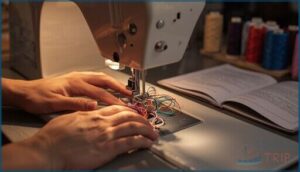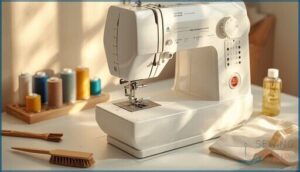This site is supported by our readers. We may earn a commission, at no cost to you, if you purchase through links.
Your first serger project probably won’t look like a store-bought garment, and that’s perfectly okay. These machines can feel like they have a mind of their own, with multiple threads flying around, mysterious tension dials, and blades that trim your fabric as you sew.
The learning curve is real, but here’s the good news: once you understand how your serger works, you’ll wonder how you ever finished seams without one. The key is mastering a handful of fundamental techniques that transform those wobbly, unraveling edges into professional-looking finishes.
From threading without tears to troubleshooting tension issues, these serger sewing tips for beginners will help you move past the frustrating early days and start creating garments you’re genuinely proud to wear.
Table Of Contents
Key Takeaways
- Start with a budget-friendly serger that includes automatic threading or color-coded guides, adjustable differential feed, and clear tension dials—you don’t need fancy features to create professional seams.
- Master the threading sequence (upper looper, lower looper, then needles right to left) and adjust tension one dial at a time in small steps to troubleshoot most stitch problems.
- Begin with forgiving projects like knit infinity scarves, fabric napkins, or pajama shorts to build confidence while learning how your serger handles different fabrics and seam finishes.
- Keep your serger running smoothly by cleaning lint weekly with a soft brush, replacing needles every 8-16 hours of sewing, and oiling metal parts regularly to prevent 38% of common repair issues.
Choosing a Serger for Beginners
Walking into a sewing store to pick out your first serger can feel overwhelming, especially with all the buttons, dials, and technical terms thrown around. The good news is you don’t need the fanciest machine to get started—just one that covers the basics and won’t leave you scratching your head.
Let’s break down what actually matters when you’re choosing a beginner-friendly serger.
Key Features to Look For
When you’re shopping for your first serger machine, a few basics make all the difference. Focus on these must-haves:
- Automatic threading or color-coded guides to simplify serger threading and tension
- Adjustable differential feed to handle stretchy or delicate fabrics smoothly
- Multiple stitch options (3- or 4-thread) for versatility
- Easy blade adjustment for clean edge finishing
- Clear tension dials for choosing the right thread settings
These features transform serger setup and operation from frustrating to fun. Understanding the serger key features is essential for making an informed purchase decision.
Budget-Friendly Beginner Models
You’ll find excellent budget options for your first serger without emptying your wallet. The Brother 1034D remains a favorite among beginners, offering 1,300 stitches per minute for around $250–270. If you’re watching pennies, the Singer SO230 delivers similar speed at Amazon’s lowest price point.
For a serger that grows with you, consider the Janome MyLock 454D—it bridges beginner projects into intermediate work beautifully.
When selecting a serger, understanding the differential feed system is essential for smooth fabric handling.
Essential Serger Parts and Functions
Once you’ve picked your serger machine basics, let’s look at what makes it work. Every serger has needles and loopers that weave threads together for that professional finish. Here’s what you need to know:
- Serger blades trim fabric edges as you sew
- Loopers create the signature overlock stitch
- Threading paths guide each strand through color-coded routes
- Differential feed prevents stretching or puckering
Understanding tension and stitch control helps you master any project.
Setting Up Your Serger Machine
Getting your serger ready to sew isn’t as scary as it looks, but it does take some patience at first. You’ll need to learn how to thread it properly, adjust a few key settings, and understand what those extra features actually do.
Let’s walk through the basics so you can set up your machine with confidence.
Threading The Serger Step-by-Step
Threading your serger might feel like solving a puzzle at first, but following the right sequence makes all the difference. Start with the upper looper, then the lower looper, followed by your needles—right to left.
Most machines include threading tools or tweezers to help guide thread through tight spots. Keep thread tails about six inches long to prevent unthreading as you work.
Adjusting Tension, Stitch Length, and Width
Once your serger is threaded, tension control becomes your best friend. Most machines default around 4 on each dial for balanced stitches on medium fabrics. Adjust one dial at a time in small steps—about 0.5—to fine-tune thread tension without overcorrecting.
Stitch length usually sits at 2.5–3 mm for standard seams, while stitch width adjusts how much fabric your blade trims, directly impacting seam quality and thread management.
Understanding Differential Feed and Blade
Differential feed manages how your serger deals with fabric stretch and gathers. The dial usually ranges from 0.5 to 2.0, with 1.0 as neutral for stable wovens. Meanwhile, blade adjustment determines cutting width—the distance between your knife and needle—directly affecting seam quality and overlock stitch placement.
- Set differential feed around 1.5–2.0 for stretchy knits to prevent wavy seams
- Use 0.8–1.0 for lightweight wovens to reduce puckering
- Adjust cutting width so looper threads sit right at the trimmed edge
- Test settings on fabric scraps before starting your project
Basic Serger Sewing Techniques
Now that your serger is threaded and ready to go, it’s time to learn how to actually use it. Mastering a few basic techniques will make the difference between wobbly, homemade-looking seams and polished, professional results.
Let’s cover the essential skills you need to start and stop seams cleanly, handle seam allowances like a pro, and finish edges that look store-bought.
Starting and Stopping Seams Correctly
One of the biggest fears for a beginner is watching your hard work unravel, right? To lock serger stitches at the start, chain off about 4-6 inches, then weave that thread tail into the seam with a needle. At the stop, chain off again and tuck the tail back through your stitches.
This simple threading technique for seam start security prevents unraveling beautifully.
Managing Seam Allowances
Think of your seam allowance as your safety net—too narrow, and you risk fit disasters. For most garments, aim for a 5/8-inch seam allowance, though lightweight fabrics work beautifully at 1/2 inch.
Here’s what matters for seam width control:
- Mark your seam line before trimming for accuracy
- Adjust the blade position based on fabric thickness
- Use throat plate guides to maintain consistent fabric edges
Test on scraps first—your serger techniques will improve with practice, and those serger seam finishes will look professional in no time.
Finishing Edges for a Professional Look
Your serger transforms raw fabric into retail-worthy pieces when you master edge finishing. Start with a three-thread overlock stitch—it manages 70% of professional garment edges beautifully.
For delicate fabrics, switch to a rolled hem to reduce fraying by up to 92%. Match your thread choices to fabric weight, test seam quality on scraps, and remember: proper fabric selection sets you up for those crisp, professional results every time.
Easy Serger Projects for Beginners
Now that you’ve got the basics down, it’s time to put your serger to work on some real projects. Starting with simple, forgiving items helps you build confidence while mastering your machine’s quirks.
Here are three beginner-friendly projects that won’t intimidate you but will still give you that satisfying feeling of creating something useful.
Knit Infinity Scarf Tutorial
Ready to create something cozy and wearable in under an hour? A knit infinity scarf project is perfect for mastering serger settings and sewing techniques on stretch material.
Start with two 12-by-60-inch knit fabric pieces, adjust your differential feed slightly above neutral, and use a 4-thread overlock stitch.
This beginner project teaches you how knit fabrics behave while you make something you’ll actually wear.
Simple Fabric Napkin Project
Want something even simpler than a scarf? Fabric napkins are your speed-run project. Grab some woven cotton—batik works beautifully—and cut 12-by-12-inch or 18-by-18-inch squares depending on your napkin size preference.
Use a three-thread narrow or rolled hem for edge finishing. You’ll complete a full set in under an hour, practicing tension control while creating something actually useful for your kitchen table.
Stretchy Pajama Shorts for Practice
Pajama shorts let you practice stretch fabrics on real garments. Start with a beginner-friendly pattern drafted for serger seams—usually 3/8 inch allowances—and grab about 1 yard of stable knit fabric like jersey.
These beginner projects teach you essential sewing techniques for knit garments:
- Sewing curved crotch seams smoothly
- Managing seam finishing at inseams
- Attaching elastic waistbands without bulk
Choose small prints to hide early tension wobbles.
Troubleshooting Common Serger Issues
Even the best sewists hit a snag now and then, and sergers can throw a few curveballs when you’re just getting started. The good news is that most serger hiccups have simple fixes once you know what to look for.
Let’s walk through the most common issues you’ll face and how to get your machine running smoothly again.
Fixing Thread Breakage and Loose Stitches
Thread breakage and loose stitches often trace back to one culprit: incorrect threading. Always raise your presser foot before threading—this opens the tension discs so thread seats properly. After threading each path, gently tug to confirm engagement.
If stitches still look loose, check that thread isn’t bypassing tension discs entirely. Old or weak thread also snaps easily, so swap it for fresh, quality spools.
Adjusting for Fabric Bunching or Skipped Stitches
Fabric bunching often stems from overly tight tension on your upper or lower threads—the main culprit in over 80% of cases. Try adjusting tension gradually, just a notch at a time.
Skipped stitches? Check your needle first. A dull or bent needle causes about 40% of skipping problems.
Also, tweak your differential feed above 1.0 for stretchy fabrics to minimize bunching and keep stitches smooth.
Resolving Uneven or Wavy Seams
Wavy seams often trace back to your differential feed setting—turn it up between 1.2 and 2.0 for stretchy knits to tame that wavy edge.
Seam tension matters too; overly tight stitches cause puckering and distortion.
Lower your presser foot pressure when working with delicate fabrics, and always test thread calibration on scraps.
These troubleshooting tweaks will flatten your serger seams beautifully.
Essential Serger Maintenance Tips
Your serger isn’t a “set it and forget it” kind of tool. A little care goes a long way in keeping it running smoothly and stitching beautifully for years to come.
Here’s what you need to know about maintaining your machine.
Cleaning and Oiling Your Serger
Think of your serger like a car—it runs smoother when you keep it clean and well-oiled. Serger maintenance and care starts with regular lint removal using a soft brush, not canned air, which can push debris deeper inside.
For serger oiling frequency, aim to clean and oil weekly if you sew often, or every three months for lighter use. Quality serger lubrication at marked points keeps your machine humming along beautifully.
Blade and Needle Inspection
Your serger’s blade and needle deserve a quick look at least once a week. Check for nicks, dullness, or bending—these small signs can cause big problems like skipped stitches or wavy edges.
Replace needles every 8–16 hours of sewing time, and swap blades when fabric starts bunching. Catching blade wear and needle damage early saves you from frustrating threading issues and costly repairs down the road.
Best Practices for Longevity and Performance
Want your serger to last years longer? A few smart habits make all the difference. Experts say regular maintenance can extend machine life by 20% or more, and it’s easier than you think.
- Clean lint after every big project—dust causes 38% of minor repairs
- Oil metal parts each time you deep clean for smoother performance
- Use premium thread quality to cut breakage by up to 55%
- Schedule annual performance audits to catch small issues early
These serger maintenance basics keep your machine humming beautifully.
Frequently Asked Questions (FAQs)
How do I finish seams without a serger?
You can finish seams using a zigzag stitch, pinking shears for woven fabrics, French seams on delicate materials, bias tape for curved edges, or an overcasting foot to prevent fraying beautifully.
Can I use a serger to sew buttonholes?
Standard sergers can’t create traditional buttonholes—they lack the lockstitch mechanism needed for durability. You’ll need a regular sewing machine or hand-sewing for proper buttonholes on your projects.
How do I store my serger when not in use?
Keep your serger in a covered bin or dust cover on a stable surface between 32°F and 86°F.
Store threads in lidded containers, retract accessories, and place felt under the presser foot for protection.
Can I use regular sewing thread in a serger?
You can use regular sewing thread in your serger, but thread compatibility has limits. Regular threads lack the fineness serger optimization requires, causing bulky seams.
Thread quality matters—high-grade threads perform better, though serger thread types remain ideal.
How do I adjust the stitch length on a serger?
Most serger machines have a stitch length dial on the side, usually marked in millimeters. Turn the dial to adjust—start at 5 to 3 mm for medium-weight fabrics, then test on scrap material.
Can I use a serger without a regular sewing machine?
Yes, technically you can—especially for knit projects like T-shirts and leggings—but you’ll hit serger limitations fast.
Buttonholes, zippers, and topstitching need a regular sewing machine for complete garment construction.
What type of thread works best for sergers?
Polyester cone thread works beautifully for most serger projects. Look for 40–50 thread weight, which balances strength with minimal bulk.
Woolly nylon stretch fibers excel for knits, while cotton threads create softness but generate more lint.
How do I prevent fabric from curling at edges?
Adjust your differential feed above 0 to reduce stretch and curling on knits. Balance needle and looper tension so threads meet at the fabric edge.
Press seams with steam, then let them cool flat for best results.
Do I need special needles for different fabric types?
Absolutely. Fabric needle types make a real difference—ballpoint serger needles glide through knits without snagging, while sharp needles handle wovens cleanly.
Needle size matters, too, matching thread compatibility to your fabric’s weight ensures smooth stitching.
Conclusion
Funny how the machine that once seemed impossibly complicated becomes the one you reach for first. Your serger transforms from intimidating contraption to trusted workhorse once you’ve practiced these serger sewing tips for beginners.
Thread it confidently, adjust tension without second-guessing, and watch those raw edges disappear under perfectly aligned stitches. Start with simple projects, celebrate your wobbly first attempts, and keep your machine clean.
Before long, you’ll be finishing seams faster than you ever thought possible.
- https://maggieframestore.com/blogs/maggieframe-news/mastering-serging-thread-types-techniques-and-troubleshooting-for-professional-results
- https://www.onehundreddollarsamonth.com/10-serger-tips-for-beginners/
- https://thesewinggallery.net/blogs/the-sewing-gallery/why-you-need-a-serger-tips-and-techniques-for-beginners
- https://www.youtube.com/watch?v=HnzxO8VnBGI
- https://drency.com/what-are-the-risks-of-using-a-serger-machine/














